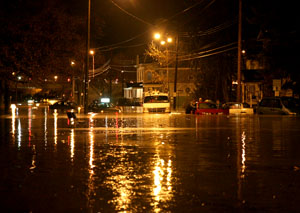
Students living on Binghamton’s West Side may have been surprised by the extent of the flash floods caused by the Nov. 16 rains — and city officials have recently confirmed that the cost of the damage was indeed higher than the massive June floods.
A team led by Luke Day, commissioner of public works, and Brian Kessler, city engineer, surveyed the damage caused by last month’s flood. Although the flood was short, the damage encountered by the team was widespread.
“Make no mistake about it, the flash flood last Thursday [Nov. 16] caused far more damage to our infrastructure than the historic June flood,” Day said. “The water came with such volume and force in such a short time that our streets, curbs, sidewalks and ditches were just thrashed.”
In a press release provided by the office of Mayor Matt Ryan, the city’s survey team placed the cost of the flood at around $6.5 million. By comparison, the flood that made headlines in June caused only about $211,000 in damages.
The cost of these two floods, along with the devastation they brought, has left many wondering if enough steps are being taken to prevent flood damage — and many student renters are considering their responsibilities as tenants.
Like every natural disaster, floods often bring up the question of liability. However, the landlord usually bears the brunt of damages.
“There are no properties that I know of that sustained anything besides water damage,” said Sal Farfaglia, a representative of the Landlord’s Association. “However, any damage to the property due to flooding is the responsibility of the landlord.”
Most property owners already have insurance that covers flood damage.
“There’s usually a high deductible that goes with it,” said Farfaglia.
The areas hit worst were located along Spring Forest Avenue, as well as parts of the East and South Sides. Thirsty’s Bar and Lounge off the Vestal Parkway claimed to have sustained $60,000 worth of damage.
“I certainly hope these floods send a clear signal to Albany and Washington,” Ryan said in the press release. “Maintaining and upgrading our domestic infrastructure is a matter of public safety and regional security.”
Daphne Gathers, a neighborhood development specialist with the City of Binghamton, expressed concern over the long-term effects of last month’s flood.
“There are dozens of homes that had their water heaters and furnaces knocked out only weeks after having brand new ones put in with the FEMA money from June’s flood,” said Gathers, who is now working to find aid for the area’s residents affected by the flood.
For an area whose residents often suffer from economic hardship, the damage caused by the flood has the potential to create suffering for many.
In light of this, Gathers has asked the people of Binghamton to help their fellow residents.
“We’re right on the cusp of winter, and restoring heat to our residents in need is a top priority.”


